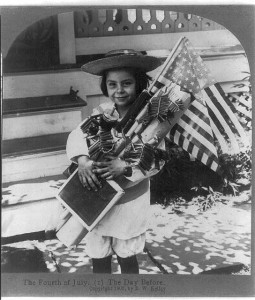‘Flag’ derived from a sound
By James Breig
Have you ever listened to a flag?

For more than two centuries, Americans have seen them. Whether large and flying smartly in the wind from a mast on the U.S.S. Constitution…or medium-sized and carried proudly by soldiers during the Battle of Gettysburg…or small and waved enthusiastically by families at a Fourth of July parade this year, an American flag looks great.
It also sounds great. Listen to the ship’s flag snap in the breeze…to the Gettysburg flag flutter in the wind…to the flap of the flag as a child waves it back and forth.
 Now you have an idea about the probable origin of the word “flag.” The Oxford English Dictionary is considered the best source of definitions of words as well as their etymologies – explanations of where words came from. Most English words derive from other languages, but some imitate sounds. An example of what are termed onomatopoetic words is “bow-wow.” The word is an imitation of the sound a dog makes. “Chirp” and “whoosh” are other examples.
Now you have an idea about the probable origin of the word “flag.” The Oxford English Dictionary is considered the best source of definitions of words as well as their etymologies – explanations of where words came from. Most English words derive from other languages, but some imitate sounds. An example of what are termed onomatopoetic words is “bow-wow.” The word is an imitation of the sound a dog makes. “Chirp” and “whoosh” are other examples.
That’s probably also the case with “flag,” according to the OED. Dating the birth of the word to at least the 16th century, the dictionary says that “flag” originated when people imitated what they heard as a flag snapped. “It may plausibly be supposed to be an onomatopoetic formation,” says the dictionary, “expressing the notion of something flapping in the wind.”
 There are other possibilities, the OED admits. Perhaps “flag” evolved from “flage,” a 12th-century word for a diaper, or from “flacg,” meaning a piece of cloth. But it’s more likely that “flag” came from “flap” – and that both words imitate what people heard when they looked up at a mast…over to a marching soldier…or down to a child’s hand.
There are other possibilities, the OED admits. Perhaps “flag” evolved from “flage,” a 12th-century word for a diaper, or from “flacg,” meaning a piece of cloth. But it’s more likely that “flag” came from “flap” – and that both words imitate what people heard when they looked up at a mast…over to a marching soldier…or down to a child’s hand.
